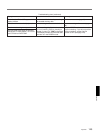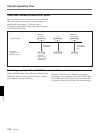
158 Appendix
Appendix
S/N
Signal-to-Noise ratio. The relation
of the strength of the desired signal
to the accompanying electronic
interference, the noise. If S/N is
high, sounds are reproduced with
less noise and pictures are
reproduced clearly without snow.
Search
The search function enables
recorded images or time codes to
be viewed while the tape is played
back at various forward or reverse
speeds, as a means of locating a
particular scene in the taped
program.
Standby-off mode
One of the stop modes. In this
mode, head drum rotation is
stopped and the tape tension is
slackened. It is not possible to
switch instantaneously from this
mode to recording or playback
mode. This mode is not harmful to
the tape or heads.
Standby-on mode
One of the stop modes. In this
mode, the head drum continues
rotating and the tape remains
wound onto the drum. This mode
enables instantaneous switching to
recording or playback mode. To
prevent damage to the tape or
heads, the device automatically
switches from standby-on mode to
standby-off mode after a certain
period of time.
S video connectors
Input/output connectors for
separate Y (luminance) and C
(chroma) signals. This method
eliminates interference between Y
and C signals that can occur in
conventional composite video
signals to obtain a higher-
resolution picture.
Sync
This refers to the sync
(synchronization) signal. The sync
signal is used as a reference signal
for duplicating the scanning
patterns recorded via a camera
when playing back the recording
on a monitor. The sync signal
actually includes two signals: a
horizontal sync signal and a
vertical sync signal.
Time code
The time code is a tape position
information signal that includes
time and frame data that are
recorded onto the tape when
shooting so as to facilitate
searching of editing points and
recorded scenes when viewing or
editing.
User bits
These are also referred to as
“users’ bits”. The user bits are a
32-bit segment of the time code
recording area. The user can select
what to record in this segment and
how to use the recorded data. For
example, it can be used to record
date information in addition to the
time code data or ID numbers for
tape reels or programs.
Video gain
Amount of amplification for video
signals, expressed in decibels (dB).
White balance adjustment
In the light of a particular color
temperature, to adjust the white
levels of the R, G, and B channels
of a color video camera so that any
white object shot in that light is
reproduced as a truly white image.
Zebra pattern
Striped patterns which appear in
the viewfinder to indicate areas of
the image where the video level is
about 70 IRE (NTSC) or 70%
(PAL). This unit can show areas
where the video level is 100 IRE
(NTSC) or 100% (PAL).
Glossary


















